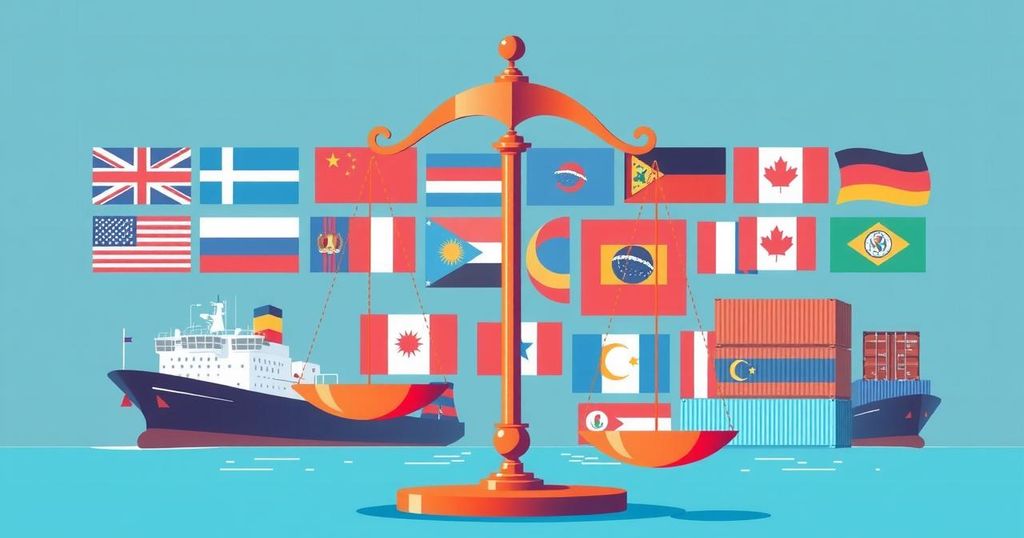economics
Politics
AMERICA, ASIA, ASSOCIATED PRESS, BRAZIL, DONALD TRUMP, ECONOMICS, EUROPEAN UNION, FOX NEWS, INDIA, INFLATION, KA, NATIONAL SECURITY, NORTH AMERICA, PETER NAVARRO, POLITICS, REPUBLIC, SOUTH AMERICA, SOUTH KOREA, THE ASSOCIATED PRESS, TREASON, TRUMP, UNITED STATES, US, WHITE HOUSE
Leila Ramsay
0 Comments
Overview of President Trump’s Reciprocal Tariffs Effective April 2
President Trump’s reciprocal tariffs, set to begin on April 2, aim to protect U.S. industries and generate government revenue by mirroring duties from other countries. These measures risk increasing consumer prices and could provoke retaliatory actions from affected nations. The economic implications remain uncertain as negotiations with trading partners are postponed until after the tariffs are enacted.
Since returning to office in January, President Donald Trump has aggressively threatened tariff implementations. Beginning April 2, he has touted reciprocal tariffs, claiming that this would release the United States from reliance on foreign imports. Trump noted that these tariffs would match the import duties imposed by other nations on U.S. products, according to a report from The Associated Press.
White House Press Secretary Karoline Leavitt stated that specific details regarding the proposed tariffs would be announced, but the timing depends solely on President Trump. Such tariffs are intended to protect American industries, enhance revenue for the federal government, and leverage negotiations with international partners. However, economists caution that these broad tariffs could be counterproductive.
Tariffs consequently result in increased consumer prices and potential losses for businesses globally, stemming from higher costs and decreased sales. The introduction of import taxes, alongside uncertainty in trade relations, has already incited concern in financial markets and dampened consumer confidence.
As the implementation date approaches, it remains unclear what Trump’s reciprocal tariffs will entail. These could involve various tariff rates or duties across different goods, reflecting those imposed by partner countries along with their value-added taxes and subsidies. Senior Counselor for Trade Peter Navarro suggested that these tariffs might raise approximately $600 billion, equating to an average of 20 percent.
The United States and India are reportedly finalizing a portion of a bilateral trade agreement but have not indicated any exemption on tariffs. Recent trade discussions have taken place in New Delhi shortly before the anticipated launch of Trump’s tariff plan. Additionally, import taxes on Canada and Mexico may come into effect soon, following a delay authorized by Trump that is set to expire at the beginning of April.
Commencing on April 2, Trump will also enforce a 25 percent tariff on imports from any nation purchasing oil or gas from Venezuela. A similar 25 percent duty on automotive imports will initiate at midnight, with an expansion of these tariffs to include auto parts predicted shortly thereafter.
The White House anticipates that these new tariffs will generate approximately $100 billion in revenue. Previously established tariffs that have begun include a 10 percent levy on Chinese imports and a 25 percent tariff on steel and aluminum products. These measures have incited retaliatory responses from Beijing, notably targeting coal and liquefied natural gas products.
Canada has initiated counter-measures for Trump’s tariffs, whereas Mexico has not yet enacted formal retaliatory tariffs, likely aiming to de-escalate trade tensions. Given Trump’s history, additional tariff implementations remain probable, as he has already threatened new import taxes on various goods, including copper and pharmaceuticals.
As comments suggest, President Trump will refrain from negotiating with other countries regarding these tariffs until after they take effect. The European Union has announced its own measures in response to U.S. tariffs, targeting American products such as beef and bourbon, with these retaliatory actions phased from April 13.
In summary, President Trump’s imposition of reciprocal tariffs beginning April 2 aims to bolster American industries by matching import duties set by other nations. While the potential for significant revenue generation exists, economists warn of adverse effects on consumer prices and market stability. Negotiations with international partners appear stalled until these tariffs take effect, further complicating global trade relations.
Original Source: www.hindustantimes.com




Post Comment